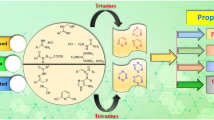Abstract
A single crystal X-ray investigation of the yellow 2-[N-(2-hydroxyethyl) carboxamide]-3-methylquinoxaline 1,4-dioxide, a commercially available growth promoter used in agricultural stock farming, shows that the molecule is planar. The dihedral angle between the benzene and heterocyclic rings is 0.5°. The N(1)-O(1) and N(2)-O(2) distances are: 1.286(1) and 1.304(1) Å. The C(1)-C(2) bond of the pyrazine ring is not lengthened by substitution at the C(1) and C(2) atoms and is 1.421(2) Å. The atoms O(1) and O(2) deviate by 0.036(2) and 0.123(2) Å from the least-squares plane through the heterocyclic ring. The deviation of the C(12) atom is −0.012(2) Å. The plane through the atoms C(1), C(9), N(3), and O(3) makes an angle of 100.5(2)° with the heterocyclic ring plane. Intermolecular hydrogen bonds O(4)-HO(4)⋯O(3) between the hydroxyl and carbonyl groups generated alternating, antiparalled chains extending in thea direction. The crystals are triclinic,P¯1 (No. 2), witha=7.469(2),b=8.111(2),c=10.357(3) Å,α=80.11(2),β=88.90(2), γ=67.73(2)°, andV=571.3(2) Å3. The structure was solved by direct phase determination guided by negative quartets and refined by full-matrix least squares to anR value of 0.041 for 2159 observed reflections.
Similar content being viewed by others
References
Bertschinger, H. U. (1976)Arch Tierheilkd. 118, 397.
Beutin, L., Preller, E., and Kowalski, B. (1981)Antimicrob. Agents Chemother. 20, 336.
Coulthard, C. E., and Hale, L. J. (1955)Br. J. Pharmacol. 10, 394.
Dawson, T. A., and Scott, K. W. (1972)Br. Med. J. 111, 469.
DeTitta, G. T., Edmonds, J. W., Langs, D. A., and Hauptman, H. (1975)Acta Crystallogr. A 31, 3472.
Diamond, R. (1969)Acta Crystallogr. A 25, 43.
Gedek, B. (1979)Zentralbl. Veterinaermed. Reihe B,26, 7.
Grabowski, M. J., Stepień, A., Cygler, M., and Wajsman, E. (1977)Acta Crystallogr. B 33, 2851.
Hennessy, T. D., and Edwards, J. R. (1972)Vet. Rec. 90, 187.
Hoskins, B. D., and Lyon, P. M. (1972)Vet. Rec. 90, 396.
International Tables for X-Ray Crystallography (1974) Vol. 4 (now distributed by D. Reidel, Dordrecht), pp. 55, 99, 149.
Kennard, O. (1981) “The binding of bifunctional intercalators to DNA,” inMolecular Structure and Biological Activity, Proc. Meeting, J. F. Griffin and W. L. Duax, eds. (Elsevier, New York), pp. 303–313.
Kennard, O., Cruse, W. B. T., Viswamitra, M. A., Sheldrick, G. M., and Jones, P. G. (1980) Am. Crystallogr. Assoc. Meet., Alabama, Abstract.
Kirchgessner, M., and Roth, F. X. (1977)Z. Tierphysiol. Tierernaehr Futtermittelkd. 38, 23.
Kopfmann, G., and Huber, R. (1968)Acta Crystallogr. A 24, 351.
McCann, J., Choi, E., Yamasaki, E., and Ames, B. N. (1975)Proc. Natl. Acad. Sci. USA 72, 5135.
MacDonald, L., and Arora, S. K. (1981)Acta Crystallogr. B 37, 1445.
Negishi, T., Tanaka, K., and Hayatsu, H. (1980)Chem. Pharm. Bull. 28, 1347.
North, A. C. T., Phillips, D. C., and Mathews, F. S. (1968)Acta Crystallogr. A 24, 351.
Rainier, R. H., Chalquest, R. R., Babcock, W. F., and Thrasher, G. W. (1973)J. Am. Vet. Assoc. 163, 457.
Rinkus, S., and Legator, M. S. (1979)Cancer Res. 39, 3289.
Sheldrick, G. M. (1976)Shelx 76, Program for Crystal Structure Determination (University of Cambridge, England).
Sheldrick, G. M. (1982) InComputational Crystallography, D. Sayre, ed. (Oxford University Press, New York), p. 506.
Sparks, R. A. (1976)Crystallographic Computing Techniques, F. R. Ahmed, ed. (Munksgaard, Copenhagen), p. 452.
Stepień, A. (1977)Acta Crystallogr. B 33, 2854.
Stepień, A. (1981)Acta Crystallogr. B 37, 2087.
Stepień, A., Grabowski, M. J., Cygler, M., and Wajsman, E. (1976)Acta Crystallogr. B 32, 2084.
Svensson, C. (1976)Acta Chem. Scand. Ser. B 30, 581.
Tinland, B. (1967)Theor. Chim. Acta 8, 361.
Tucker, M. J. (1975)J. Natl. Cancer Inst. 55, 137.
Visser, G. T., and Vos, A. (1971)Acta Crystallogr. B 27, 1793.
Williams, B. J., and Babcock, W. F. (1976)Vet. Med. Small Anim. Clin. 71, 957.
Yoshimura, H., Nakamura, M., and Koeda, T. (1981)Mutat. Res. 90, 49.
Author information
Authors and Affiliations
Additional information
Commercially known asOlaquindox.
Rights and permissions
About this article
Cite this article
Bartczak, T.J., Galdecki, Z., Wolf, W. et al. Studies of substituted quinoxaline-di-N-oxides. Part 1. Crystal structure and molecular conformation of 2-[N-(2-hydroxyethyl)carboxamide]-3-methylquinoxaline 1,4-dioxide. Journal of Crystallographic and Spectroscopic Research 18, 165–174 (1988). https://doi.org/10.1007/BF01181908
Received:
Issue Date:
DOI: https://doi.org/10.1007/BF01181908




